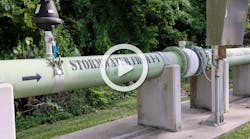To Sweep or Not to Sweep?
The City of San Diego Storm Water Department is committed to protecting water quality and preserving natural resources in San Diego. Clean water regulations enacted by the U.S. Environmental Protection Agency and the California State Water Resources Control Board require municipalities to implement projects that address local water quality issues. In San Diego, more than two dozen water body segments are considered impaired.
Study Setup
The department implemented a Street Sweeping Pilot Study to determine if enhanced sweeping is a cost-effective solution for reducing pollution and meeting existing and future total maximum daily load compliance targets. The two goals of the project are:
Three pilot communities were chosen for this study: Mid-City, which impacts Chollas Creek and San Diego Bay; Clairemont, which drains to Tecolote Creek and Mission Bay; and La Jolla Shores, which drains to two areas of special biological significance. Locations for this study were selected based on a high potential for metal contaminants.
The two-year study began in April 2008; at the time of publication, it was near completion. Two wet seasons and two dry seasons were included to increase the validity of the data.
The first phase included dry-weather debris analysis to determine the most effective and efficient sweeper technology and sweeping frequency. The second phase included a wet-weather analysis to determine if enhanced sweeping produced any beneficial impacts to water quality.
Equipment tested against the city’s currently owned mechanical sweeper were a regenerative-air sweeper and a vacuum sweeper.
Facts & Figures
Research has shown that because fine particulates (e.g., brake dust) tend to collect in gutters, street sweeping is more effective when the sweepers can reach the gutters. Therefore, streets contained within the study areas were posted with “no parking” signs for the duration of the study. Because a focus of the study was to identify the impacts of enhanced sweeping, the sweeping frequencies in all three areas were increased at different rates.
During the first year, the sweeping frequency in Mid-City was increased from an average of one full sweep (both sides of the street) per month to two full sweeps per week. During the second year, the frequency was reduced to one full sweep per week for comparison. In both the Clairemont and La Jolla Shores communities, previously nonposted routes that were swept once every other month were increased to two full sweeps per month.
All debris collected from each pilot area was weighed prior to being isolated in individualized collection bins for sampling. A debris analysis was subsequently conducted and a synopsis of the dry-weather results is presented in Figure 1 (see page 12).
The sweeper comparison portion of the study was implemented by sweeping pilot areas with three sweeper types for a set period of time, at the same frequency and using the same analysis protocol. In Mid-City, the comparative machine analysis was performed by operating each sweeper—the mechanical, the vacuum and the regenerative-air—for a minimum of three consecutive weeks for approximately 12 months. In Clairemont, a similar analysis was conducted for all three machines. In the La Jolla Shores community, only the mechanical and regenerative-air sweepers were compared.
Finally, to determine the beneficial impacts of enhanced sweeping on water quality, a wet-weather comparative analysis was conducted in Mid-City. Samples were taken during three storm events from a single road, half of which had been swept with the mechanical sweeper and the other half by the vacuum sweeper for three weeks prior to the rain event. The samples were collected to prevent co-mingling of runoff from the segments swept by the two machines, and control samples were taken from an adjacent unswept street. Samples were analyzed for sediment, metals and pesticides.
Initial Conclusions
Since the study began, San Diego has swept the equivalent of more than 9,500 miles of streets and collected more than 381 tons of trash and debris. A significant amount of heavy metals has been removed from city streets as well.
The Storm Water Department initially promoted the study with media, information sheets and website updates. While responses were generally positive, many of the more complex scientific details were not easily understood. Also, new route time frames, new parking restrictions and the amount of signage installed caused concern for many citizens.
Although the city continues to analyze data in order to make recommendations, preliminary results indicate that street sweeping has a positive impact on water quality by providing an effective means of reducing pollutant concentrations in storm water runoff.
Comparisons indicate that a vacuum sweeper is more effective in reducing pollution than a mechanical sweeper under certain conditions (e.g., topography). The data also indicates that conducting aggressive sweeping using a vacuum sweeper is more efficient than sweeping at the same frequency with a mechanical sweeper.
Download: Here

